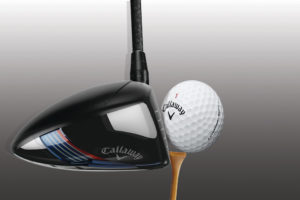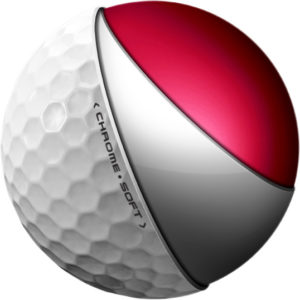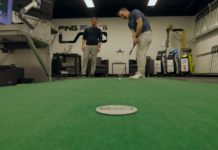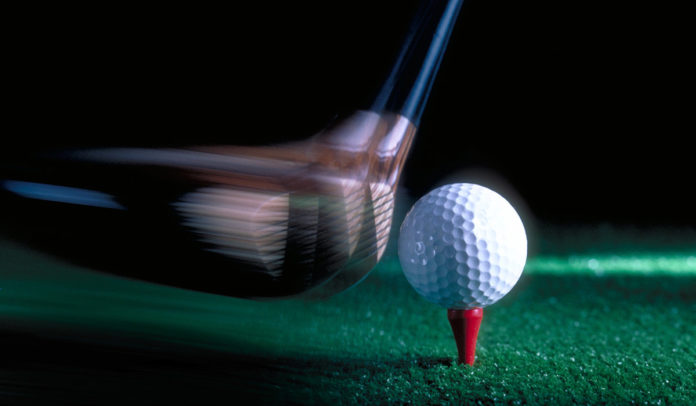This is the first of a two-part post on the physics of when a club meets a ball during your swing. Part two will follow shortly after.
When club meets ball
We know it when it happens. The planets align and angels sing as we hit a perfect approach shot into a protected pin. Unknown to us, amazing things all came together at that exact moment to create that euphoric moment that keeps us coming back for more. The relationship between club path and face, the interaction between club and turf, and the backspin on the ball causing it to stop on the green were all orchestrated the moment the club started its backswing. But what actually happens when clubface meets ball? We often hear that we should be using a golf ball best suited for our swing speed. What is compression anyway? This article will explain the underlying physics and math behind club and ball impact in a way that won’t melt your brain. The image being painted by your swing coach will suddenly come into sharp focus once you understand what your equipment is actually doing at impact.
Compression
 If you’ve ever needed a compression bandage, you have a good idea, albeit painful, of what compression is. Grab a golf ball out of your bag…go ahead, do it…and try to squeeze it with your bare hand. Difficult to believe it can be flattened by a golf club, but we’re talking about a hunk of steel traveling at 80+ mph! Although in contact for less than a thousandth of a second, that’s enough time for the clubface to flatten, or compress, the ball. It stands to reason that the faster the club head, the more the ball compresses. “But what makes one ball compress more than another, and why do I care?” you might be asking. Good questions.
If you’ve ever needed a compression bandage, you have a good idea, albeit painful, of what compression is. Grab a golf ball out of your bag…go ahead, do it…and try to squeeze it with your bare hand. Difficult to believe it can be flattened by a golf club, but we’re talking about a hunk of steel traveling at 80+ mph! Although in contact for less than a thousandth of a second, that’s enough time for the clubface to flatten, or compress, the ball. It stands to reason that the faster the club head, the more the ball compresses. “But what makes one ball compress more than another, and why do I care?” you might be asking. Good questions.
Imagine a super ball that is perfectly elastic. Now drop your imaginary ball onto a very hard surface and notice that it bounces back to your hand at the exact point you let go. In fact, you could remove your hand and the ball would continue bouncing there forever, or until you stop it. Of course, a golf ball is not perfectly elastic. If a ball manufacturer could create a perfectly elastic golf ball, it would be game over for all other ball manufacturers. Rather, a golf ball is inelastic, which simply means it gives up some of its energy at impact. To measure elasticity, we use something known as the Coefficient of Restitution, or CoR. Isaac Newton was the first to quantify the degree to which a ball would bounce (although he did not call it the CoR). He noticed that a ball dropped from a certain height would always return to a consistent height (always less than the initial height). Newton was a smart dude. He started dropping the ball from differing heights and took note of the velocity just before and just after ground impact. For a given ball he noticed that the ratio of the velocity just after impact to that just before impact produced that same value, which we call the ball’s CoR. Imagine dropping a ball of clay. It’s velocity after impact is zero, since it doesn’t bounce at all. If we return to our perfectly elastic ball, it would leave the ground at exactly the same velocity that it hit, giving this ball a CoR of 1. All other balls have a CoR between 0 and 1. Technically, CoR is a measurement of the energy transfer in a collision of two objects.
 A given golf ball has a prescribed CoR, so we can now determine its compression, right? Well, not really. You see, golf ball manufacturers have taken great strides in improving golf ball performance. By using several layers a golf ball can be manufactured with a softer outer layer. This allows the ball to flatten more upon impact, giving the golfer that elusive sense of “feel” around the green. However, it is the club head speed, in essence, that determines the CoR. A swing of around 20 mph might produce a CoR of about 0.8, while the CoR of a driver moving at 100 mph is more like 0.6. So now we actually have two terms that really don’t mean the same thing. Compression can be thought of as “feel,” while the CoR is really a measurement of energy transfer between two objects. The more a ball is compressed, the better the “feel” of the hit. When you hit that pure iron approach shot, you are actually acknowledging compression. The more you compress the ball, the more surface of the ball is in contact with the club face. You might say that you had good “touch” on that shot.
A given golf ball has a prescribed CoR, so we can now determine its compression, right? Well, not really. You see, golf ball manufacturers have taken great strides in improving golf ball performance. By using several layers a golf ball can be manufactured with a softer outer layer. This allows the ball to flatten more upon impact, giving the golfer that elusive sense of “feel” around the green. However, it is the club head speed, in essence, that determines the CoR. A swing of around 20 mph might produce a CoR of about 0.8, while the CoR of a driver moving at 100 mph is more like 0.6. So now we actually have two terms that really don’t mean the same thing. Compression can be thought of as “feel,” while the CoR is really a measurement of energy transfer between two objects. The more a ball is compressed, the better the “feel” of the hit. When you hit that pure iron approach shot, you are actually acknowledging compression. The more you compress the ball, the more surface of the ball is in contact with the club face. You might say that you had good “touch” on that shot.
Too Much of a Good Thing
For Newton, there was just a bouncing ball. The CoR was the rebound velocity divided by the impact velocity. Piece of cake. When we transfer this concept to the golf ball, we get another term: smash factor. This is almost like the CoR, but instead we’re considering the speed of the club head and the initial ball speed. Smash factor is defined as the speed of the ball divided by the speed of the club head. If the ball stuck to the club head after impact, we would have a smash factor of zero. For our perfectly elastic ball from earlier, we would get a smash factor of two, which is to say the ball would leave the club face at exactly twice the speed of the club face. One would logically presume that golf equipment manufacturers would be eager to get a ball/club combination that would get as close to the theoretical perfect impact (a smash factor of 2). Enter the USGA…
 Recall that CoR is a measure of energy transfer. The USGA has put a limit on the interaction between club and ball of CoR = 0.83. This basically means that you cannot have more than 83% energy transfer from head to ball. In this way the USGA has put a limit to just how far a golf ball can travel and, thus, has leveled the playing field. This is similar to NASCAR in which all cars must use a carbureted V8 engine. A rocket engine is faster, but that would be unfair to the other racers. It would also be difficult to handle, but that’s a different problem. After some math and using ideal conditions, the best we could do approaches a smash factor of about 1.47. If you hear a golf announcer talk about an amazing shot with a smash factor of 1.5, they are alluding to a nearly perfect golf shot. It also makes them sound cool.
Recall that CoR is a measure of energy transfer. The USGA has put a limit on the interaction between club and ball of CoR = 0.83. This basically means that you cannot have more than 83% energy transfer from head to ball. In this way the USGA has put a limit to just how far a golf ball can travel and, thus, has leveled the playing field. This is similar to NASCAR in which all cars must use a carbureted V8 engine. A rocket engine is faster, but that would be unfair to the other racers. It would also be difficult to handle, but that’s a different problem. After some math and using ideal conditions, the best we could do approaches a smash factor of about 1.47. If you hear a golf announcer talk about an amazing shot with a smash factor of 1.5, they are alluding to a nearly perfect golf shot. It also makes them sound cool.
Putting an Energetic Spin on Things
During contact a golf club can slow down about 10 mph for a full swing. What happened to the other 10 mph? In part 2 we will address the concept of energy transfer, which is essentially converting some of the energy of the moving club into the stationary ball. We will also learn about what makes a golf ball spin.
This article has touched upon some pretty difficult topics and will continue to do so in future installments. How do you apply this newfound knowledge? Do you play the golf balls you found in the weeds while looking for your drive? Me too. We just need to be aware that not all golf balls are created equal and could actually be hurting our game. Do squirrels wave white flags whenever you tee it up, or do worms get sucked out of their homes when you hit a screamer six inches off the fairway?
When you have questions about equipment – and the golf ball you choose is part of your equipment – turn to your local GolfTEC Coaches. They are there to help you make informed and intelligent decisions on whether your equipment is right for your swing.
In Part 2, I’ll talk about how keeping your club face clean impacts spin, roll and more.










